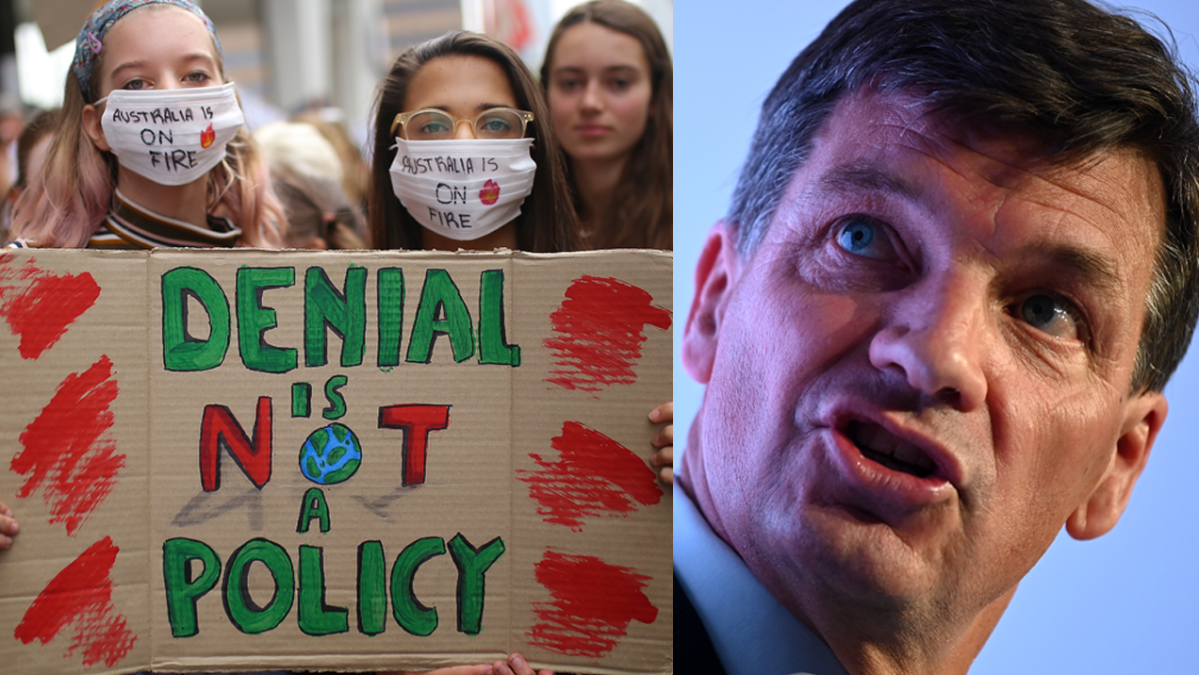
The government is finally pretending to care about climate change. But its solution is a galaxy-brain set of policies which are too little, too late.
This week, Energy Minister Angus Taylor gradually unveiled the government’s new climate plan, based on recommendations from an expert panel. It’s a piss-poor attempt at making Australia look like we’re acting on climate change, when really we’re doing nothing of the sort.
What are the panel’s recommendations?
Last year, the government formed a panel of experts to investigate new ways to reduce emissions. Rather than being chaired by a scientist or environmentalist, it was led by former Business Council of Australia president Grant King.
The panel’s findings have been described as the next step in the government’s “technology not taxes” approach. The idea is that polluters should be rewarded for good behaviour instead of being punished for bad behaviour.
Its main recommendations were cutting red tape for emissions-reducing projects, matching companies’ investments in these projects, and broadening existing funds to include “the widest possible range of technologies that reduce emissions”.

How does this fit into the government’s wider climate plan?
It’s more of the same, really.
The government has made no secret about wanting to prop up the fossil fuel industry, and the new scope to include “the widest possible range” of tech means coal and gas are now green, apparently.
By adopting 21 out of 26 measures from the review, including the major points outlined above, the government will continue supporting fossil fuels which, no matter how “clean” they are, will always be bad for the environment.
The government’s already mentioned carbon capture technology, while newly-leaked documents also show the government also has massive plans for investments in natural gas.
carbon capture and storage is a marketing hustle; designed to make the industry look like part of the solution. it doesn’t exist. they have no intention of doing it, and even if they could it would be ruinously expensive. just shut. it. down.
— Scott Ludlam (@Scottludlam) May 21, 2020
“The Government will target dollar for dollar co-investment from the private sector and other levels of government to drive at least $4 billion of investment that will reduce emissions across Australia,” Taylor said on Tuesday.
“We have seen considerable success in the land and electricity sectors to reduce emissions – this is about supporting and capitalising on new and exciting opportunities in the agriculture, manufacturing, industrial and transport sectors to build on that success.”
Why is it garbage?
Technology as opposed to taxes would be great, if it were solely renewable energy or other zero-emissions technology.
Instead, much of the technology the government’s looking at is the kind of thing which still pollutes, just marginally less.
The plan is to “balance” renewables with natural gas, rather than push for renewables all the way. And even this is just a plan, something which past governments have chosen to ignore.
One supposed green credential of the roadmap is investment in hydrogen.
But hydrogen fuel cells are needlessly inefficient compared to existing battery technology. Too often, hydrogen is also isolated using electricity generated from – you guessed it – fossil fuels. It’s the one thing Elon Musk is right about.
Meanwhile, the government will also reward polluters who pollute less. This is paying them to do the bare minimum. Encouraging fossil fuels to be cleaner encourages them to still exist in the first place.
Who would have thought a recovery commission stacked with fossil fuel executives would have nothing to say about the arts, higher education or tourism? 🤷♂️
— Dan Gocher (@justdanfornow) May 20, 2020
What should we be doing instead?
We should be ending out reliance on natural gas and coal, rather than digging up dead dinosaurs to feed a dying industry.
In Australia, coal-fired power stations typically have a lifespan of around 29 years. That means coal power stations which might benefit from the policy in the near future will be churning out emissions for decades to come.
Considering we should already be well underway in the switch to renewables, this is the opposite direction to be heading in.

What does the future look like?
“Our 2030 Paris target is a floor not a ceiling,” Taylor said.
“These reforms will position Australia to overachieve on our 2030 Paris target while maintaining a strong economy.”
While that is a great sentiment – the UN itself says the Paris targets don’t go far enough – achieving it by rewarding polluters just fucked.
It’s also a bit misleading. While Australia is technically on track to hitting our Paris target, that’s mainly thanks to an accounting loophole. And there may be more wiggle-room like this in future.
Due to the coronavirus pandemic, global emissions fell by a massive 17% percent. This is great, albeit temporary, news.
But if we look at historical emissions targets, temporary crises have always been used to fudge the numbers to appear is if we’re making progress. Both Russia and Germany easily achieved their Kyoto targets due to economic upheaval in both countries in the 90s.
The same applies to Australia now. In reality, we haven’t made that much progress. We’ve just stopped leaving the house for a bit.







